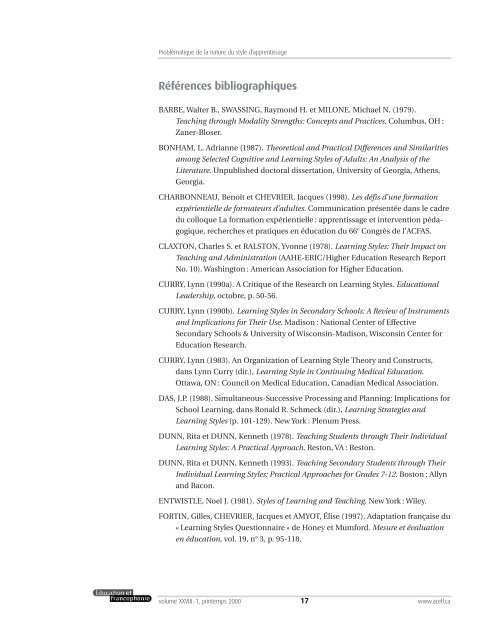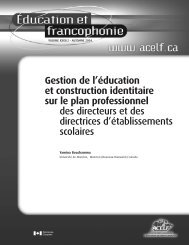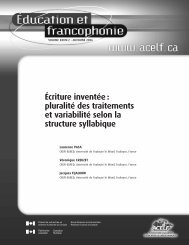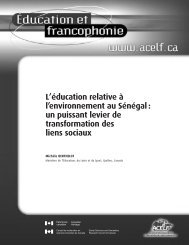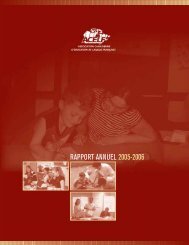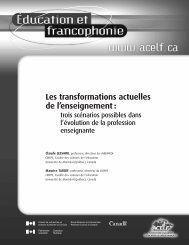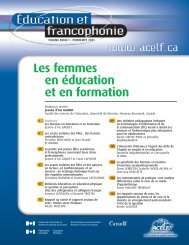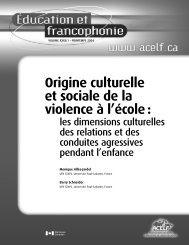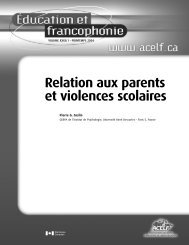Problématique de la nature du <strong>style</strong> d’apprentissageConclusion<strong>Le</strong>s conceptions actuelles du <strong>style</strong> d’apprentissage sont nombreuses et parfoisopposées. Elles cherchent cependant toutes à rendre compte de régularités et decohérences intersituationnelles chez des apprenants. Si certains auteurs les considèrentcomme des habitudes acquises au cours des années de formation, d’autres yvoient la manifestation de dispositions personnelles, voire de caractéristiques innéespratiquement immuables. Que ce soit en termes de « routines », de préférences ou detendances, deux caractéristiques semblent importantes à retenir. D’une part, la personneéprouve une attirance, une prédilection pour certaines façons de faire. D’autrepart, la personne s’identifie à ces manières d’agir en situation d’apprentissage.L’apprenant accorde donc une signification particulière à ces conduites, qui ontcomme attribut de le caractériser. Il peut y accoler les pronoms « je » et « moi »,puisque ces conduites sont source de différences individuelles.Un <strong>style</strong> d’apprentissage n’est pas unidimensionnel, il comporte plusieursdimensions. Toutefois, le nombre et l’organisation de ces dimensions semblent trèsvariables d’un modèle à l’autre. Selon nous, c’est à partir du point de vue de l’apprenantque la recherche doit s’orienter. C’est aussi là qu’un <strong>style</strong> d’apprentissage prendsa valeur. La question de la stabilité pose aussi problème à cause du manque de clarificationde la notion de cohérence trans-situationnelle. Quel degré de stabilité doitonexiger pour parler de <strong>style</strong> d’apprentissage? Encore ici, la recherche devra se faireplus abondante et plus systématique pour mettre en évidence la signification quel’apprenant accorde à cette stabilité. Nous aurions peut-être là un début de réponseà la question de l’origine du <strong>style</strong> d’apprentissage. Nous avons opté pour une approchedynamique du <strong>style</strong> d’apprentissage. De manière heuristique, il semble plus valablede considérer que le <strong>style</strong> d’apprentissage se construit et peut se modifier.L’étude du <strong>style</strong> d’apprentissage a été trop longtemps dominée par une perspectivemécaniste et déterministe. Il est temps de prendre le virage constructiviste et deredonner à l’apprenant son autonomie. La psychologie cognitive nous invite à considérerla personne comme un agent actif de son apprentissage, ayant le pouvoir dechoisir ses conduites et ses stratégies d’apprentissage et la manière de les mettre enœuvre (Schmeck, 1983). Peu importe l’origine de ces choix, il faut considérer quel’apprenant conserve un pouvoir sur la situation, le pouvoir de décider quelle conduiteet quelle stratégie il utilisera pour poursuivre son apprentissage. <strong>Le</strong> <strong>style</strong> d’apprentissageémanerait alors de la constance dans ces choix, ce dont l’apprenant (se)rendrait compte, par exemple en répondant à un questionnaire. Ainsi, le <strong>style</strong>d’apprentissage tel que manifesté dans un pattern de conduites serait issu non seulementde la représentation que l’apprenant se fait de lui-même, mais aussi de lareprésentation qu’il se fait de la situation d’apprentissage donnée.volume XXVIII : 1, printemps 200016www.<strong>acelf</strong>.ca
Problématique de la nature du <strong>style</strong> d’apprentissageRéférences bibliographiquesBARBE, Walter B., SWASSING, Raymond H. et MILONE, Michael N. (1979).Teaching through Modality Strengths: Concepts and Practices. Columbus, OH :Zaner-Bloser.BONHAM, L. Adrianne (1987). Theoretical and Practical Differences and Similaritiesamong Selected Cognitive and <strong>Le</strong>arning Styles of Adults: An Analysis of theLiterature. Unpublished doctoral dissertation, University of Georgia, Athens,Georgia.CHARBONNEAU, Benoît et CHEVRIER, Jacques (1998). <strong>Le</strong>s défis d’une formationexpérientielle de formateurs d’adultes. Communication présentée dans le cadredu colloque La formation expérientielle : apprentissage et intervention pédagogique,recherches et pratiques en éducation du 66 e Congrès de l’ACFAS.CLAXTON, Charles S. et RALSTON, Yvonne (1978). <strong>Le</strong>arning Styles: Their Impact onTeaching and Administration (AAHE-ERIC/Higher Education Research ReportNo. 10). Washington : American Association for Higher Education.CURRY, Lynn (1990a). A Critique of the Research on <strong>Le</strong>arning Styles. Educational<strong>Le</strong>adership, octobre, p. 50-56.CURRY, Lynn (1990b). <strong>Le</strong>arning Styles in Secondary Schools: A Review of Instrumentsand Implications for Their Use. Madison : National Center of EffectiveSecondary Schools & University of Wisconsin-Madison, Wisconsin Center forEducation Research.CURRY, Lynn (1983). An Organization of <strong>Le</strong>arning Style Theory and Constructs,dans Lynn Curry (dir.), <strong>Le</strong>arning Style in Continuing Medical Education.Ottawa, ON : Council on Medical Education, Canadian Medical Association.DAS, J.P. (1988). Simultaneous-Successive Processing and Planning: Implications forSchool <strong>Le</strong>arning, dans Ronald R. Schmeck (dir.), <strong>Le</strong>arning Strategies and<strong>Le</strong>arning Styles (p. 101-129). New York : Plenum Press.DUNN, Rita et DUNN, Kenneth (1978). Teaching Students through Their Individual<strong>Le</strong>arning Styles: A Practical Approach. Reston, VA : Reston.DUNN, Rita et DUNN, Kenneth (1993). Teaching Secondary Students through TheirIndividual <strong>Le</strong>arning Styles: Practical Approaches for Grades 7-12. Boston : Allynand Bacon.ENTWISTLE, Noel J. (1981). Styles of <strong>Le</strong>arning and Teaching. New York : Wiley.FORTIN, Gilles, CHEVRIER, Jacques et AMYOT, Élise (1997). Adaptation française du« <strong>Le</strong>arning Styles Questionnaire » de Honey et Mumford. Mesure et évaluationen éducation, vol. 19, n° 3, p. 95-118.volume XXVIII : 1, printemps 200017www.<strong>acelf</strong>.ca


